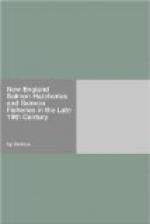The embryos of salmon begin to burst the shell in the month of March, and the 1st of April may be stated as the mean date of hatching. If the open-air troughs are in order—and we aim to have them so—the eggs are counted out into lots of 2,000 or 4,000 each and placed before hatching in their summer quarters. The water is at that time very cold, the development of the alevins is slow, and it is not until the latter part of May that the yolk sack is fully absorbed. June 1 is, therefore, the date when feeding is ordinarily begun. The growth of the fish is at first slow, the water being still cool, but is accelerated as the summer passes away. In October and November, beginning commonly about the middle of October, most of the fish are counted out and liberated, but a small number, rarely more than 15,000, being carried through the winter at the station. The reserved fish are sometimes left until midwinter in their summer quarters, and with a careful covering of the conduits and banking of the troughs themselves each with coarse hay and evergreen boughs it is possible to keep them there the year round; but for ordinary winter storage there is provided a system of sunken tanks covered by a rough shed with a constant water supply. These tanks are molasses hogsheads, securely hooped with iron, sunk nearly their entire depth into the ground, each with an independent water supply and waste, the perforation for the latter being near the surface. They have a capacity of from 100 gallons of water upward, and will carry safely each 500 to 700 fish in their first winter, that is, just approaching the age of one year.
This arrangement has answered its purpose fairly well, and in a very rigorous climate or where the water is very cold it is to be recommended; but since its construction it has been discovered that at Craig Brook it is not at all difficult to protect the ordinary troughs in such a way as to insure their safety from freezing, and their attendance through the winter is less troublesome than that of the sunken tanks.
A list of the articles employed for food at the station since its foundation, if designed to include those used on an experimental as well as a practical scale, would be a long one, and I will content myself with naming the following: On a practical scale we have used butcher’s offal, flesh of horses and other domestic animals by the carcass, fresh fish, maggots; and on an experimental scale, pickled fish, fresh-water mussels, mosquito larvae, miscellaneous aquatic animals of minute size.
In the production of maggots we have also made use of large quantities of stale meat from the markets and some barrels of fish pomace, in addition to the articles mentioned above.
The butcher’s offal comprises the livers, hearts and lights of such animals as are slaughtered in Orland and Bucksport—mainly lambs and veals. These are collected from the slaughter-houses twice or thrice weekly, and preserved in refrigerators until used. The quantity of such material to be had in the vicinity has been inadequate to our needs and we have been compelled to look in other directions for food.




